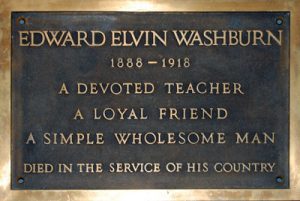The last in a series of essays featured in conjunction with Greenwich Faces the Great War.
A Forgotten Soldier in a Forgotten War
By Peter Berg and Karen Frederick

Among the soldiers who should be honored on Memorial Day is Edward Elvin Washburn. In 2006, a custodian found this brass plaque in the basement of a former high school building in Greenwich. The plaque was put on display in the Greenwich High School Media Center with the following information:
…Although it was determined that Mr. Washburn died in military service on October 17, 1918 in Cleveland, Ohio, it has never been established that he was a Greenwich teacher. …The GHS community hopes its placement here might aid in the search for information regarding Mr. Washburn and the provenance of this plaque. At the very least it serves as a memorial of this teacher’s call to duty and his ultimate sacrifice.
A little more than nine years after the plaque was found and 96 years after the death of Edward Elvin Washburn, Peter Berg has uncovered information about this man and his life.
Edward was born on April 13, 1888 in China, Maine, the fourth of six children of Edith Elvin Crosby Washburn and Willis Wendell Washburn. His father’s careers included harness maker, insurance salesman, postmaster, town clerk and justice of the peace.



Resolved—that the Committee place on record the expression of its deep sorrow for the untimely death of Edward E. Washburn, who was an officient [sic] and loved teacher in the Greenwich High School for three years; who in that brief time had earned the respect and esteem of the community; and who entered with enthusiasm the military service of his country, in which he gave high promise of creditable achievement—a good citizen, a model teacher, a patriotic soldier.”
On December 18, 1918, a service flag containing 118 stars was dedicated at the high school. Of those stars, 117 were blue. There was one gold star for Corporal Edward E. Washburn, “the former head of the Science Department, who died in the service.” Washburn’s name does not appear on a brass plaque at Town Hall, because, although he was a Greenwich resident who died in the military service, he did not die in combat or overseas. Karen Frederick is the Curator of Collections and Exhibitions Coordinator at the Greenwich Historical Society. The Greenwich Historical Society thanks Peter Berg for his research on this forgotten soldier.
